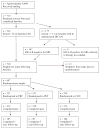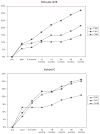School-based prevention of depressive symptoms: A randomized controlled study of the effectiveness and specificity of the Penn Resiliency Program
- PMID: 17295559
- PMCID: PMC4469032
- DOI: 10.1037/0022-006X.75.1.9
School-based prevention of depressive symptoms: A randomized controlled study of the effectiveness and specificity of the Penn Resiliency Program
Abstract
The authors investigated the effectiveness and specificity of the Penn Resiliency Program (PRP; J. E. Gillham, L. H. Jaycox, K. J. Reivich, M. E. P. Seligman, & T. Silver, 1990), a cognitive-behavioral depression prevention program. Children (N = 697) from 3 middle schools were randomly assigned to PRP, Control (CON), or the Penn Enhancement Program (PEP; K. J. Reivich, 1996; A. J. Shatté, 1997), an alternate intervention that controls for nonspecific intervention ingredients. Children's depressive symptoms were assessed through 3 years of follow-up. There was no intervention effect on average levels of depressive symptoms in the full sample. Findings varied by school. In 2 schools, PRP significantly reduced depressive symptoms across the follow-up relative to both CON and PEP. In the 3rd school, PRP did not prevent depressive symptoms. The authors discuss the findings in relation to previous research on PRP and the dissemination of prevention programs.
Copyright 2007 APA, all rights reserved.
Figures


References
-
- Angold A, Costello EJ, Worthman CM. Puberty and depression: The roles of age, pubertal status, and pubertal timing. Psychological Medicine. 1998;28:51–61. - PubMed
-
- Clarke GN, Lewinsohn PM. Instructor’s manual for the Adolescent Coping with Stress Course. 1995 Retrieved December 2, 2005, from Kaiser Permanente Center for Health Research Web site: http://www.kpchr.org/acwd/acwd.html.
-
- Gillham JE, Hamilton J, Freres DR, Patton K, Gallop R. Preventing depression among early adolescents in the primary care setting: A randomized controlled study of the Penn Resiliency Program. Journal of Abnormal Child Psychology. 2006;34:203–219. - PubMed
-
- Gillham JE, Jaycox LH, Reivich KJ, Seligman MEP, Silver T. Unpublished manual. University of Pennsylvania; Philadelphia: 1990. The Penn Resiliency Program.
-
- Gillham JE, Reivich KJ, Jaycox LH, Seligman MEP. Preventing depressive symptoms in schoolchildren: Two year follow-up. Psychological Science. 1995;6:343–351.
Publication types
MeSH terms
Grants and funding
LinkOut - more resources
Full Text Sources
Medical
Research Materials
Miscellaneous

